Roasted Tomatillo Salsa Verde Canning Recipe
This post may contain affiliate links, which means that I may receive a commission if you make a purchase using these links. As an Amazon Associate I earn from qualifying purchases.
Canning roasted tomatillo salsa is a great way to preserve the abundance of tomatillos that the garden produces. Jars of tomatillo salsa verde come in handy for all your favorite Mexican dishes.
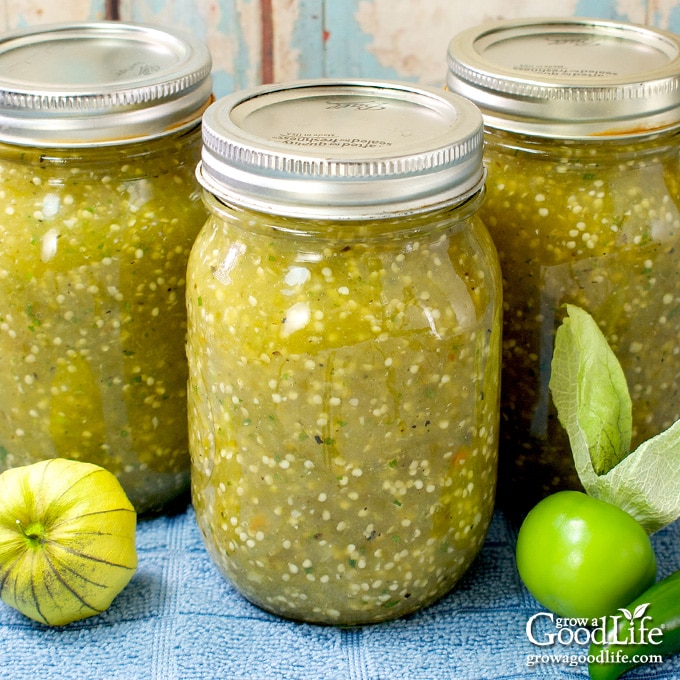
The first time I grew tomatillos in the garden, I thought six plants would be a good number to grow. Ok, ok, I hear the snickers from those of you with experience growing tomatillos.
Tomatillos (Physalis philadelphica), also called husk tomatoes, are native to Mexico and are not very common to our corner of the world, Maine. They are related to the tomato, but grow enclosed in a papery husk.
Tomatillos produce a lot of fruit even when growing in cooler climates, so consider yourself warned if you are thinking of growing some for the first time. Each plant can put out about ten to fifteen pounds.
On a positive note, I had a lot of tomatillos to experiment with. Biting into my first ripe fruit was an unexpected pleasure. I thought it would taste similar to a tomato. Instead, it has a tart and slightly citrus flavor.
The first thing I tried is making with tomatillos was a small batch of salsa verde. It was good! Then I tried roasting it. Roasting the vegetables adds a delicious smoky flavor and mellows the acidity of the tomatillos: Small Batch Roasted Salsa Verde Recipe.
Finding a safe canning recipe for salsa verde that tasted good was challenging. In fact, the recipe I published here previously from the NCHFP website required bottled lemon juice to make it safe for home canning. Many commented that there was too much lemon flavor, and I had to agree.
Finally, I tried a salsa verde recipe from The All New Ball Book of Canning and Preserving that uses fresh lime juice and cilantro. I tested it several times, and it tastes so much better. If you tried the old recipe and were disappointed with the lemon flavor, please give this one a shot.
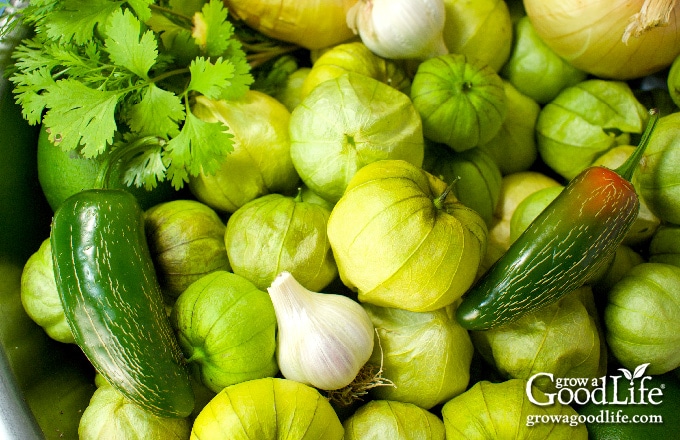
This roasted tomatillo salsa is delicious as a dip with tortilla chips, drizzled on tacos and fajitas. We also like it pouring it over some boneless chicken breasts and cooking in a crockpot to make shredded chicken for salsa verde chicken enchiladas similar to this recipe.
Steps for Canning Roasted Tomatillo Salsa
Tomatillos are easy to preserve into jars of salsa verde. There is no peeling or seeding, simply roast the vegetables, combine the ingredients, blend together, simmer briefly, and process in a water bath canner.
When canning, it is important to follow a recipe that has been scientifically tested. This is the “Roasted Salsa Verde” recipe from The All New Ball Book of Canning and Preserving. It has been doubled for a canner load of 6 pint-sized jars, and the seasonings have been adjusted.
If you are new to canning, it may be helpful to review this article on water bath canning at the National Center for Home Food Preservation website.
A more detailed and printable recipe can be found at the bottom of this article. These are the illustrated steps for making and preserving roasted tomatillo salsa in a water bath canner:
Step 1: Gather the Kitchen Equipment
- 4 rimmed baking sheets or a large roasting pans to roast the vegetables
- Rubber gloves for handling hot peppers
- Food processor to blend the salsa
- Kitchen scale
- Water bath canner and canning rack
- 6 pint sized canning jars
- Canning lids and bands (new lids for each jar, bands can be reused)
- Canning tools: jar lifter, canning ladle, funnel, and bubble popper
- Plus basic kitchen supplies such as a large prep bowl, large saucepan, towels, knife, and a cutting board.
Step 2: Prepare the Vegetables
Peel the husks off the tomatillos and rinse them well to remove the sticky residue. Cut the tomatillos in half and add to the roasting pans. Peel and cut your onions into chunks, wash the jalapeño peppers and add them whole to the roasting pans. Peel your garlic and scatter them over the vegetables.
Roast the vegetables in a preheated oven until everything is softened and charred, about 15-20 minutes. Flip half way through so the vegetables roast evenly. Remove the pan from the oven and let it cool for 5-10 minutes.
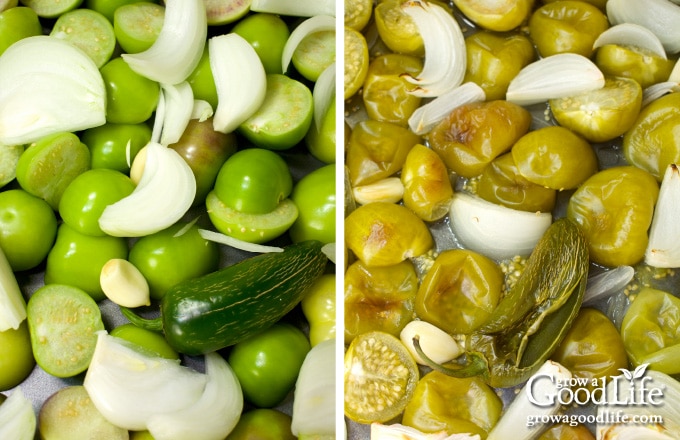
Step 3: Prepare the Canning Jars and Lids
While the vegetables are roasting, prepare the jars, set up the canner, and organize your work area.
Wash your canning jars, lids and bands, and canning tools with warm, soapy water and rinse well. Look the jars over carefully, and eliminate any with chips and cracks. Set lids and bands aside until you are ready to use them.
Place the canner on the stove and insert the canning rack. Set the jars in the canner, add water to cover, and simmer (180˚F) for 10 minutes. Keep hot until you are ready to fill them.
Step 4: Make the Salsa Verde
While wearing gloves, remove stems and seeds from the jalapeño peppers. You can keep the seeds if you like more heat.
Working in batches, add the roasted vegetables and their liquid to a food processor. Process until smooth, and then pour into a large sauce pot. Continue processing the vegetables in batches until done.
Add the lime juice, cilantro leaves, salt, pepper, cumin and stir to combine. Bring the pot to a simmer (180˚F), and then turn the heat to low and keep warm.
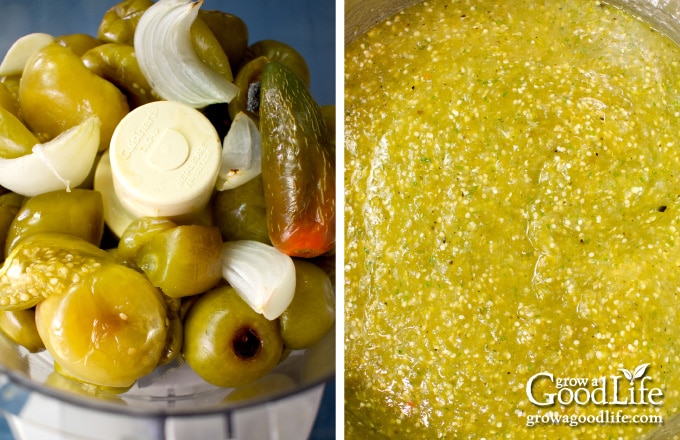
Step 5: Can the Salsa
Spread a dry kitchen towel on the counter. Use the jar lifter to remove a hot jar from the canner, drain, and place on the towel. Keep the remaining jars in the canner, so they stay warm.
Place the canning funnel on the jar, and ladle the hot salsa into the jar while leaving 1/2-inch headspace. Run the bubble popper through the jar to release any trapped air bubbles. Adjust the headspace again if needed.
Wipe the rim with a damp towel to remove residue. Center a lid on the jar, add the band, and screw it on until fingertip tight. Place the jar back into the canner, and repeat with the rest of the jars.
Adjust the water level so it is covering the jars by two-inches, cover the canner, bring it to a boil, and process the jars in a boiling-water canner for the times indicated in the recipe below.
Once processing time is complete, remove the jars, and let them cool undisturbed for 12 to 24 hours. After cooling for at least 12 hours, test the seals. Refrigerate any that did not seal, and use up within a week.
Wash the jars with warm soapy water, dry, label and date the jars, and store in a cool, dark location for 12 to 18 months. Wait several weeks for the salsa to develop its flavor before opening a jar.
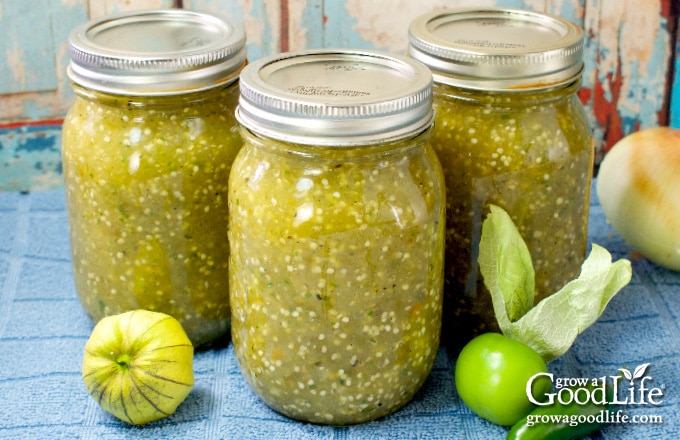
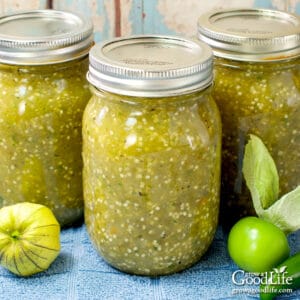
Roasted Tomatillo Salsa Verde Canning Recipe
Ingredients
- 8 pounds tomatillos husks removed
- 4 medium white onions cut into wedges
- 4 jalapeño chiles or serrano peppers
- 6 cloves garlic peeled
- 1 cup fresh lime juice or bottled lime juice
- 1/2 cup chopped fresh cilantro leaves
- 2 teaspoons kosher salt (optional for flavor)
- 1 teaspoon black pepper (optional for flavor)
- 1/2 teaspoon ground cumin (optional for flavor)
Instructions
Prepare the Vegetables:
- Preheat oven to 425˚F.
- Peel the husks off the tomatillos and rinse them well. Cut the tomatillos in half and divide up into the rimmed baking sheets or roasting pans.
- Peel and cut your onions into chunks. Add to the roasting pans.
- Wash the jalapeño peppers and add them whole to the roasting pans.
- Peel your garlic, and scatter into the roasting pans.
- Roast the vegetables in a preheated oven until everything is slightly softened and charred, about 15-20 minutes. Flip half way through so the vegetables roast evenly.
- Remove the baking sheets from the oven and let the roasted vegetables cool for 5-10 minutes.
Prepare your Canning Equipment:
- Wash your jars, lids, screw bands, and canning tools in hot soapy water. Rinse thoroughly to remove all suds. Set aside to air dry on a clean kitchen towel.
- Place the jar rack into water bath canner, place jars in the canner, and add water to cover. Bring the canner to a simmer (180˚F) for 10 minutes, and keep the jars hot until you are ready to fill them.
Make the Tomatillo Salsa Verde:
- While wearing gloves, remove stems and seeds from the jalapeño peppers. You can keep the seeds if you like more heat.
- Working in batches, add the roasted vegetables and their liquid to a food processor. Process until smooth, and then pour into a large sauce pot. Continue processing the vegetables in batches until done.
- Add the lime juice, cilantro leaves, salt, pepper, cumin, and stir to combine. Bring the pot to a simmer (180˚F), and then turn the heat to low and keep warm.
Can the Roasted Tomatillo Salsa Verde:
- Lay a dry kitchen towel on the counter. Use the jar lifter to remove a jar from the canner. Drain the water back into the canner, and place on the towel. Keep the remaining jars in the canner so they stay hot.
- Use the canning funnel and ladle to fill the jar with hot relish, leaving 1/2-inch headspace.
- Wipe the rim to remove any residue, center a lid on the jar, and screw on a band until it is fingertip tight. Use the jar lifter to place the jar back into the canner, and repeat with the remaining jars.
- Once all the jars are in canner, adjust the water level so it is two inches above the jar tops.
- Cover the canner and bring to boil over high heat. Once water boils vigorously, continue boiling for 20 minutes at altitudes of less than 1,000 feet. Adjust processing time for your altitude if necessary (See Notes).
- When processing time is complete, turn off the heat, and let the canner cool down and settle for about 5 minutes.
- Spread a dry kitchen towel on the counter. Remove the cover by tilting lid away from you so that steam does not burn your face.
- Use the jar lifter to remove the jars from canner and place on the towel. Keep the jars upright, and don't tighten bands or check the seals yet. Let sit undisturbed for 12 to 24-hours to cool.
- After 12 to 24-hours, check to be sure jar lids have sealed by pushing on the center of the lid. The lid should not pop up. If the lid flexes up and down, it did not seal. Refrigerate jar and use up within a week.
- Remove the screw on bands and wash the jars. Label, date, and store in a cool, dark place for 12 to 18 months. Allow at least 3 to 4 weeks for the salsa to develop its flavor. Once the jar is open, refrigerate and use up within a week. Yields about 6 pints.
Notes
Nutrition
This recipe was originally published July 29, 2018. It has been updated with new photos, more detailed information, and a much better tasting safe canning recipe.
You May Also Like:
- Zesty Salsa Recipe for Canning
- How to Can Tomatoes
- Seasoned Tomato Sauce Canning Recipe
- How to Can Poultry Meat
If you love salsa, consider adding our eBook, Grow a Good Life Guide to 50 Salsa Canning Recipes, to your resource library. This 72-page eBook is packed with a variety of delicious salsa recipes, including classic tomato salsas to roasted and grilled salsas to tomatillo and delicious fruit blends, all safe for water bath canning. It’s the perfect guide to help you preserve your garden harvests.

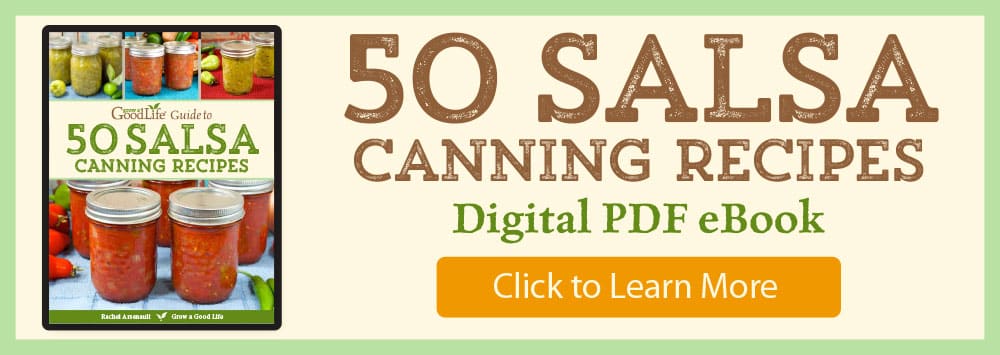
Can you use a pressure canner instead of water bath canner?
Scott, This recipe was developed and tested by Ball specifically for water bath canning, so I recommend sticking to that method to ensure quality and safety.
Do you have the weights for the onions and jalapenos? Those can vary so much in size.
Tina, Yes, I understand how sizes can vary, and you’re right—it can feel a bit vague! Ball has tested this recipe with some flexibility in mind, though. A rough estimate would be about 1.5 to 2 pounds of onions for the 4 medium white onions, and 2 to 3 ounces of jalapeños for the 4 peppers.
Since it’s a tested Ball recipe, they’ve accounted for these variations, so feel free to use these estimates as a guide while keeping the recipe safe for canning. Let me know if you have any other questions!
Can I steam can in a steam canner instead of water bath? I’m assuming same times?
Lindsey, Yes, you can use a steam canner for any water bath canning recipe as long as the recipe calls for processing times of 45 minutes or less. Be sure to follow the same processing times listed in the recipe for the water bath canner. Also, make sure to monitor the steam canner to keep the correct temperature and steam level throughout the process.
I made this tonight, and man did it turn out delicious! I used a few extra jalapeño because I really do love the heat. Will definitely be making another batch to keep us in stock for the year.
Denise, I’m so glad to hear you enjoyed the tomatillo salsa! It’s always tempting to add a little extra heat, especially if you love spicy food. However, just a quick note of caution: increasing the amount of certain ingredients, like jalapeños, in a tested and safe canning recipe may affect the acidity level and make the salsa unsafe for long-term storage. To stay on the safe side, I recommend following the recipe as written, but feel free to add extra jalapeños after opening the jar when serving.
I would like to make a double batch but I only have one half cup lime juice, can I substitute lemon juice?
Brenda, Yes, you can use lemon juice in place of the lime juice.
Love this recipe! Have made a few times this summer. Wondering, can I use quart sized jars? If so, how long should quarts be processed?
Mary P, Thank you for loving the recipe! Unfortunately, there aren’t any safe, tested canning recipes for salsa in quart-sized jars at this time. Either quart jars were not tested, or they didn’t pass the testing for safe preservation. To ensure your salsa stays safe for long-term storage, I recommend sticking with pint-sized jars and processing according to the recipe’s guidelines.
Can I can this since I’ve added avacado?
Valerie, Unfortunately, the addition of avocado makes this salsa unsafe for home canning. However, you can freeze the salsa instead! Just portion it into freezer-safe containers or bags, leaving some space for expansion, and it should store well in the freezer for several months.
I am going to try this recipe and have some frozen green tomatoes from last year, do you think it would be safe to use those with tomatillos if the overall total weight was the same?
Morgan, Yes, you can substitute green tomatoes for the tomatillos.
maybe I simmered mine a little bit longer, but I started with about 8 and 1/2 lb of tomatillos and ended up with only five and a half pints. I always throw a few half pint jars in the dishwasher to account for things like this. it was pretty good, but I wish I had read somebody else’s suggestion to add some dried peppers. I think it would have given it a little bit more smokey flavor. I had so many peppers in the oven that they didn’t get as brown as I would have liked. it was a lot of juice that came out of them so they were really just steaming in the oven instead of roasting like I would have liked. I’ll find out in a couple weeks how it tastes! I thought it was pretty good coming straight out of the pot though. thanks for sharing. another tip for growing tomatillos is that a lot of varieties require two separate plants in order to actually produce fruit. so if you’re thinking about just growing one because it makes a lot you will not get any.
Lisa, Thank you for your detailed feedback! It sounds like you put a lot of effort into making the salsa, and I’m glad you enjoyed the flavor right out of the pot. Simmering a little longer can reduce the overall yield, but it sounds like your preparation paid off with those extra jars on hand!
Did you include the juice from the roasted tomatillos and peppers? Omitting the juice can also reduce the final yield, so that could be a factor.
If you make it again, you could roast the peppers in smaller batches to get that nice browning and reduce the steaming effect. Sometimes, spacing them out more on the pan helps, too. I hope the flavor turns out just how you like it after it’s had some time to develop in the jars.
And thanks for the great tip about growing tomatillos! You’re right—tomatillos need at least two plants for good pollination and fruit production.
Enjoy your salsa, and feel free to share how it tastes after it’s had time to settle!
Thank you for this great recipe! Made this yesterday with tomatillos and green tomatoes. I did adjust the spice to my taste (lemon and lime juice, more cumin and added guajillo chile)
Ran the recipe 2x and ended up with 16 pints. That’s not a bad thing, I have millions of canning jars and supplies. I know the green tomatoes were bigger than the tomatillos and was prepared. I have dry canned for 4 years now and have not had any issues.
Steve, I’m so glad you enjoyed the recipe and that it worked well with the combination of tomatillos and green tomatoes! 😊 It’s wonderful that you’re able to put those millions of jars to good use!
That said, I do want to gently remind you that altering the proportions of ingredients can affect the safety of the final product for home canning. While it’s perfectly safe to adjust dried spices like cumin, substitute an equal amount of green tomatoes for the tomatillos by weight, and substitute another pepper for the jalapenos, increasing or changing the proportion of ingredients can alter the acidity levels, which is essential for ensuring the salsa is shelf-stable.
I also noticed you mentioned dry canning. I’d love to direct you to this resource Dry Canning Isn’t Canning, from the National Center for Home Food Preservation, which explains why dry canning is not considered safe. It’s always better to err on the side of caution when it comes to preserving food! Thank you so much for your kind words and for sharing your experience. Feel free to reach out if you have any more questions!